Receiving a letter from the IRS can feel intimidating and unsettling for many taxpayers. Official letters with the IRS seal can make the receiver wonder if they made a mistake or if they are in trouble. These anxieties are not uncommon, but the truth is, neither are these IRS notices. Luckily, most of them can be resolved easily once the taxpayer understands what they mean.
Here’s a guide to understanding the most common types of IRS notices, an explanation into why a taxpayer may receive one, and guidance for how to respond.
Why The IRS Sends Notices
The IRS communicates primarily by mail — not phone or email. Notices are typically sent for reasons such as:
- Clarifying information on a tax return
- Notifying you of a balance due
- Confirming changes made to your return
- Requesting additional documentation
- Alerting you to a possible error
Each notice is numbered in the upper right-hand corner (for example, CP2000 or Notice CP12). That code is your key to understanding the purpose of the letter. In all cases, contact us if you have questions about how to proceed.
Five Common Notices & What They Mean
1. CP2000, Proposed Changes To Your Tax Return. This notice is issued when the IRS finds a mismatch between the information you reported and what third parties (like employers or banks) reported. For example, if your W-2 shows more wages than what you entered, the IRS will propose a correction.
How To Respond: Review the notice carefully. If the IRS is correct, you can agree and pay any additional tax owed. If you disagree, you have the right to dispute it by providing supporting documentation.
2. CP12, Refund Adjustment. If the IRS corrects a math error or other mistake on your return, you may receive this notice. Sometimes, it will result in a smaller or larger refund than you expected.
How To Respond: If you agree with the correction, no action is needed. If not, you can request a reversal by contacting the IRS within 60 days of the date of the notice.
3. CP14, Balance Due. This is the most common notice. It informs a taxpayer that they owe additional tax. It will list the amount due, including penalties and interest.
How To Respond: Don’t ignore it. Pay the balance in full, set up a payment plan, or contact the IRS if you believe the notice is incorrect.
4. Letter 4883C, Identity Verification. When the IRS suspects identity theft, it sends this letter asking you to verify your identity before processing your return.
How To Respond: Follow the instructions immediately — usually by calling the IRS or verifying online. Delaying could stall your refund.
5. CP49, Refund Applied To A Debt. A taxpayer will receive this notice if they were expecting a refund but instead had it applied to past-due federal taxes or other debts (like child support or student loans).
How To Respond: The notice will explain how the refund was applied. If you disagree, you may need to contact the agency that received the payment, not the IRS.
Steps To Take
In addition to the response steps listed above, here are six more tips:
- Don’t panic. Notices are often routine and resolvable.
- Read carefully. The notice will explain the issue, next steps and deadlines.
- Check the notice number. This will help you look up details online or discuss the matter with us.
- Verify accuracy. Compare the notice to your tax return and records.
- Respond promptly. Many notices have deadlines for disputing or appealing.
- Avoid scams. The IRS will never email, text, or call demanding payment. Legitimate notices always come by mail.
Ways We Can Help
Interpreting IRS notices may be tricky, especially if it involves complex calculations or disputed information. We can review the notice for accuracy and explain what it means in plain language. In addition, we can communicate with the IRS on your behalf, help you gather documentation, file corrections, and guide you through payment plans or appeals if needed. With professional guidance, most IRS issues can be resolved without stress or confusion. Contact us with any questions regarding IRS notices.

